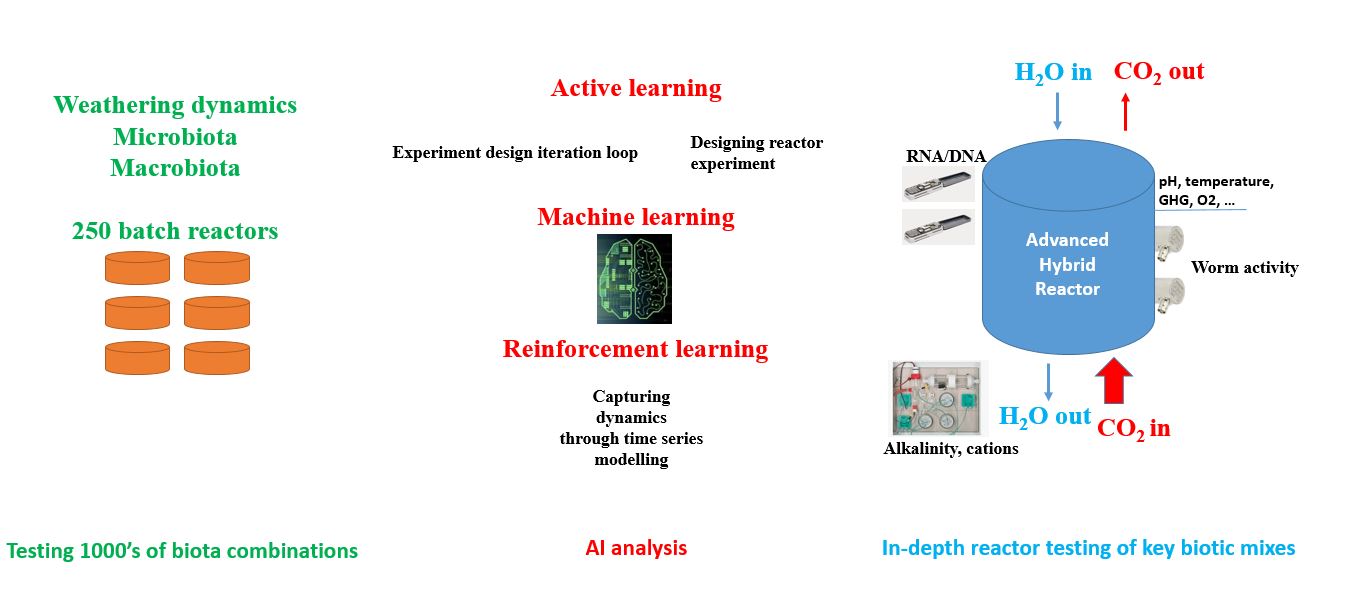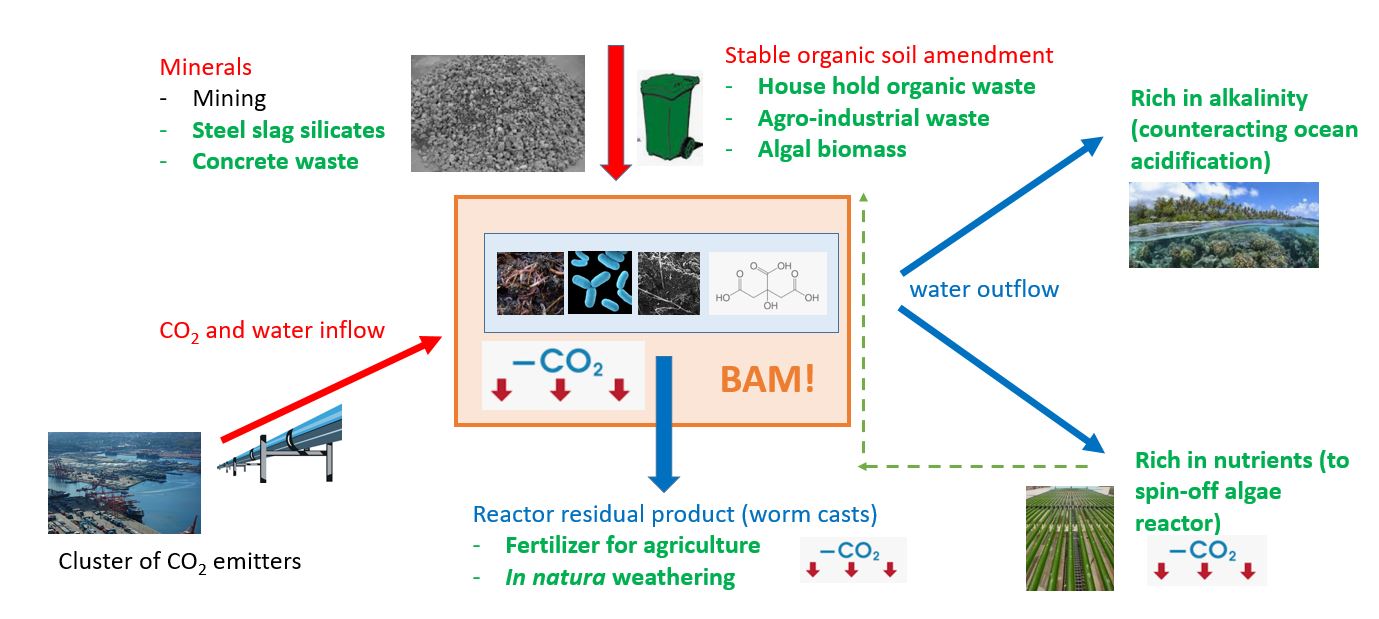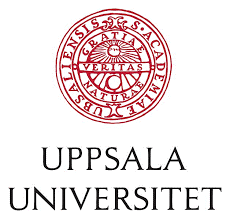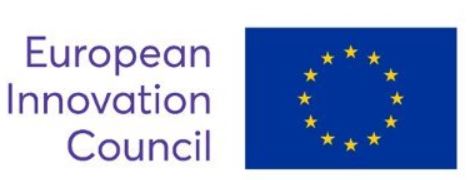Innovation
The need for negative emission technologies (NETs): Conventional climate change mitigation alone will not be able to stabilise atmospheric CO2 concentrations at a level compatible with the 2°C warming limit of the Paris Agreement. Safe and scalable NETs, which remove CO2 from the atmosphere and ensure long-term carbon sequestration, are needed to meet this goal. Fast progress is needed, especially if NETs are to serve as a risk-hedging mechanism for unexpected geopolitical events and for the transgression of tipping points in the Earth system.
BAM! centers on combining the weathering power of prokaryotes, plants, fungi and invertebrates in a multiphase hybrid reactor, setting an entirely new trajectory for enhanced weathering research. We install an unprecedented set-up of treatment combinations and high-frequency assessments of abiotic (pH, temperature, weathering rates,…) and biotic conditions (earthworm activity, bacterial and fungal metabolism, fungal growth, …). An AI-based machine learning analysis module is used to rapidly identify which conditions favor weathering rates and carbon sequestration.

Future Markets
Apart from being a potential game-changer for CO2 removal, BAM! aims to make a difference through its potential for embedment in a larger CO2-negative and sustainable agriculture/industry framework. The reactive mineral-organic-worm cast mixture in the BAM! reactor can potentially be transformed into a natural fertilizer. To align with metal and steel industry, silicates might be replaced with silicate steel slag waste from the industry itself. Implementation in harbour areas provides potential for the implementation of management strategies to improve coastal resilience against ocean acidification (alkalinity) and eutrophication (increased silicate availability).

Publications
Calogiuri T., Janssens I., Vidal, A., Van Groenigen J. W., Verdonck T., Corbett T., … & Hagens M. (2025). How earthworms thrive and drive silicate rock weathering in an artificial organo-mineral system. Applied geochemistry, 180. https://doi.org/10.1016/j.apgeochem.2024.106271
Some movies to present the construction and operation of an experimental setup to enhance mineral weathering: https://www.jove.com/b/65563/enhancing-co2-sequestration-soil-biota-approach-to-boost-mineral
Vicca, S., Goll, D. S., Hagens, M., Hartmann, J., Janssens, I. A., Neubeck, A., Peñuelas, J., Poblador, S., Rijnders, J., Sardans, J., Struyf, E., Swoboda, P., van Groenigen, J. W., Vienne, A., & Verbruggen, E. (2022). Is the climate change mitigation effect of enhanced silicate weathering governed by biological processes? Global Change Biology, 28, 711–726. https://doi.org/10.1111/gcb.15993
Janssens IA., Roobroeck D, Sardans J, Obersteiner M, Peñuelas J, Richter A, Smith P, Verbruggen E, Vicca S. (2022). Negative erosion and negative emissions: Combining multiple land-based carbon dioxide removal techniques to rebuild fertile topsoils and enhance food production. (2022) Frontiers in Climate, 4. https://doi.org/10.3389/fclim.2022.928403
Calogiuri T, Hagens M, Van Groenigen JW, Corbett T, Hartmann J, Hendriksen R, Janssens I, Janssens IA, Ledesma Dominguez G, Loescher G, Mortier S, Neubeck A, Niron H, Poetra RP, Rieder L, Struyf E, Van Tendeloo M, De Schepper T, Verdonck T, Vlaeminck SE, Vicca S, Vidal A. (2023). Design and construction of an experimental setup to enhance mineral weathering through the activity of soil organisms. J Vis Exp. 10;(201). https://doi.org/10.3791/65563
Rieder, Lukas; Amann, Thorben; Hartmann, Jens. Soil electrical conductivity as a proxy for enhanced weathering in soils. Frontiers in Climate (2024), 5. https://www.frontiersin.org/articles/10.3389/fclim.2023.1283107.
Thomas Corbett, Marcus Westholm , Anna Rosling , Tullia Calogiuri , Reinaldy Poetra , Harun Niron , Mathilde Hagens , Alex Vidal , Jan Willem Van Groenigen , Jens Hartmann , Ivan Janssens, Lukas Rieder , Eric Struyf , Michiel Van Tendeloo, Siegfried Vlaeminck , Sara Vicca, Anna Neubeck. Microbial olivine dissolution controlled by organic carbon source in small scale flow-through bioreactors, for carbon dioxide removal. (2024). npj Materials Degradation. https://www.nature.com/articles/s41529-024-00454-w
Partnership
The BIO: The Global Change Ecology Excellence Centre (GCE) at UAntwerpen has key expertise on biogeochemical carbon cycling. It performed one of the first ESW in natura experimental quantifications, showing strong constraints for ESW under soil conditions. This knowledge is complemented by the Soil Biology and Soil Chemistry research groups at WU, with key expertise on the functioning of invertebrates, and the catalysing role earthworms play in biogeochemical processes. Bio-expertise is completed by UU, specializing in siderophores as ‘tools’ for dissolving crystalline material, and in the properties of the micro-organisms that create them.
The GEO: The Institute for Geology of UHAM has key knowledge on techniques to assess weathering processes. The group of Jens Hartmann is world-leading in research on chemical weathering in the Earth System at various scales, with a specific focus on CO2 removal methods.
The Engineering: Bio-reactor development will be coordinated by the Microbial Cleantech (MCt) research group of UAntwerpen, which has core expertise regarding the development, smart design and operation of hybrid and bioreactors. The group’s methodology spans from lab- to full-scale reactors and from microbial analyses to process control and microbiome management.
The Data: The data scientists at IMEC IDLab are internationally recognized for their machine learning insights and capabilities. They are ideally placed to tackle BAM!’s complex data challenges, through their specialization in automated machine learning solutions, sensor development and connection.
Coordinator

Prof. Sara Vicca
Prof. Ivan Janssens
Dr. Harun Niron
Dr. Tom Cox
Dr. Joke Van den Berge
Past collaborator
Guillermo Ledesma
Partnership

Prof. Tim Verdonck
Iris Janssens
Thomas Servotte
Past collaborator
Prof. Steven Latré
Steven Mortier

Dr. Anna Neubeck
Prof. Anna Rosling
Dr. Abhijeet Singh
Past collaborator
Dr. Thomas Corbett


The BAM! EIC Pathfinder project has received funding from the European Union’s Horizon 2020 framework programme for research and innovation under grant agreement No 964545.


